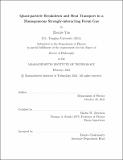Quasi-particle Breakdown and Heat Transport in a Homogeneous Strongly-interacting Fermi Gas
Author(s)
Yan, Zhenjie
DownloadThesis PDF (67.76Mb)
Advisor
Zwierlein, Martin W.
Terms of use
Metadata
Show full item recordAbstract
This thesis describes experiments on a homogeneous strongly-interacting Fermi gas, consisting of a spin mixture of ⁶Li atoms with interactions induced by a Feshbach resonance. The tunability and universality of this atomic gas make it an ideal platform to study many-body physics of interacting Fermi systems. The implementation of a uniform trapping potential enables experiments at constant density, allowing the study of transport, critical phenomena near phase transitions, and novel states of matter predicted in a narrow range of densities. Radio-frequency (rf) spectroscopy provides a powerful tool for probing singleparticle excitations in quantum gases. In particular, we employ it to study the thermal evolution of resonantly interacting spin impurities immersed in a Fermi gas. The rf spectra reveal a dramatic transition from an attractive polaronic Fermi liquid at low temperature to a classical Boltzmann gas above the Fermi temperature. In the polaron regime, the spectral width shows a characteristic 𝑇² temperature dependence, corresponding to the quasiparticle decay rate in a Fermi liquid. At high temperatures, the spectral width approaches the scattering rate of a classical, unitary Boltzmann gas, which scales as 𝑇⁻¹⸍². In the transition regime, a spectral width on the order of the Fermi energy is observed, indicating the breakdown of the quasiparticle picture of well-defined, long-lived excitations. I further describe the first direct observation of heat transport in a strongly interacting Fermi gas, using the temperature dependence of the rf spectra as a local thermometer. The superfluid phase transition in our attractive Fermi system separates two different regimes of heat propagation. While heat propagates diffusively in the normal phase, in a superfluid it propagates as a wave, called second sound. The measured speed of second sound yields the superfluid fraction, which quantifies the inertia against phase twists. The damping time scales of second sound and heat diffusion show a minimum diffusivity on the order of the quantum limit ♄/𝑚 for both modes. The diffusivity is observed to feature a peak at the phase transition temperature which is evidence for critical behavior, as seen in liquid ⁴He.
Date issued
2022-02Department
Massachusetts Institute of Technology. Department of PhysicsPublisher
Massachusetts Institute of Technology